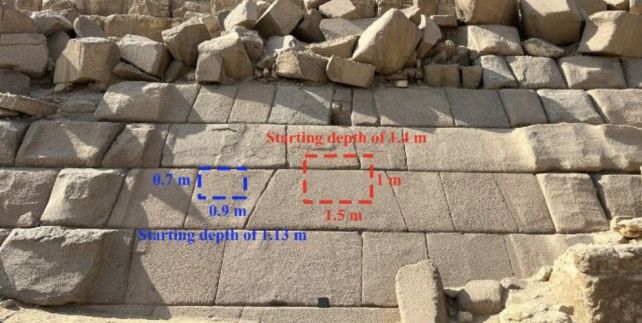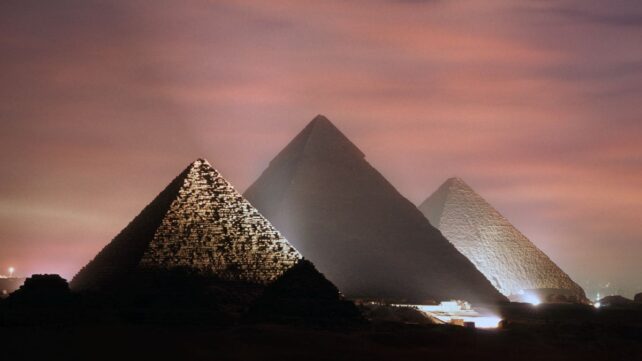Scans of the third-largest pyramid at Giza, the Menkaure pyramid, have revealed two anomalous pockets of nothing but air hiding behind its sloping stone walls.
The discovery follows earlier findings inside the Great Pyramid of Khufu, including a huge internal void and a corridor near its northern entrance. But the Menkaure cavities are dramatically different in shape, size, and layout – hinting at a very different construction history and purpose.
"The images revealed two anomalies directly behind the polished granite blocks, which would indicate the presence of air-filled voids," writes a team led by archaeologists Khalid Helal and Mohamed Elkarmoty of Cairo University.
"This interpretation was supported by a series of numerical simulations that considered various possible scenarios under real-world conditions."
Related: 'Bad Omen': Ancient Pyramid in Mexico Collapsed Into Pile of Rubble
As enormous stone monuments to long-dead kings, the pyramids of Giza have fascinated humanity for centuries. Aside from their mythology, though, the pyramids offer a dazzling window into the world of ancient Egypt, not just the importance of ancient Egyptians' funerary rites and splendor, but their ability to even build such structures in the first place.

The Great Pyramid is the largest of the monuments and receives the most attention. Menkaure, the smallest of the three main pyramids, hasn't been studied in detail since American archaeologist George Reisner conducted his excavations from 1906 to 1910.
Yet it is unique among the three pyramids for its unfinished facade of reddish granite over the limestone structure – a feature hinting at shifting architectural priorities.
All three pyramids have stood for more than four millennia as a magnificent testimony to ancient Egyptian craftsmanship; as such, it's deeply important to study them without causing further damage. In recent years, techniques and technology have emerged that allow just that, with the ability to non-invasively scan inside a structure.

This is what the researchers did as part of the ScanPyramids project. In an effort co-led by Cairo University and the Heritage Innovation Preservation Institute in France, the team used a combination of three different scanning techniques to peer behind the granite cladding on the lower portion of Menkaure.
Electrical resistivity tomography (ERT) sends a current through solid mass, measuring changes in the resistivity of different materials. Ground-penetrating radar (GPR) sends radio waves through a mass and measures how they reflect off different materials. And ultrasonic testing (UT) uses sound waves to do the same.
Using all three techniques to 'see' inside the Menkaure Pyramid, the researchers discovered two small anomalies on the eastern face that did not behave like the surrounding limestone.
The first was located about 1.4 meters (4.6 feet) below the granite, and measured around 1.5 meters wide and 1 meter high. The second, roughly 1.1 meters under the granite, measured 0.9 by 0.7 meters. Both anomalies behaved like pockets of air, not joints between the blocks.
Next, they ran simulations to determine whether there was something else that explained the data. These ruled out models suggesting that the signals could have been produced by blocks of stone with different physical properties from the surrounding material.
"It was concluded that both anomalies likely represent air-filled voids within a limestone medium, beginning directly behind the outer granite casing of the Eastern face," the researchers write.

These cavities are very different from the Khufu cavities, one of which is quite large, and the other of which is well structured. What the two pyramids have in common is that the purposes of neither of their voids are clear.
However, as Helal and his colleagues note, the configuration of the granite blocks covering the Menkaure voids is very similar to that of the blocks around the pyramid's north entrance. In 2019, independent researcher Stijn van den Hoven suggested that this could indicate a second entrance.
The researchers were unable to determine the depth of the cavities; they propose using cosmic-ray muography to investigate further. "However," they conclude, "the interpretation of the detected anomalies should be discussed among Egyptologists."
The research has been published in NDT & E International.

